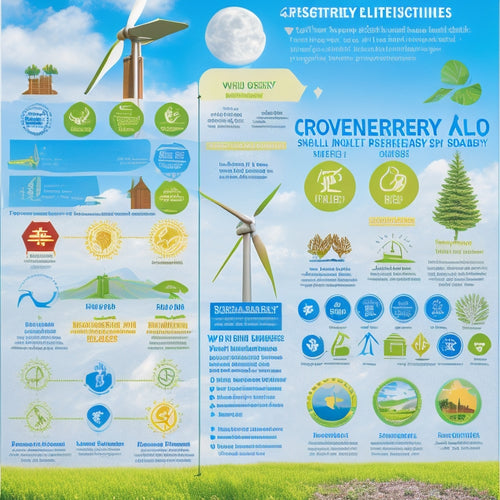Defining Style Sustainably: The Eco-Friendly Approach to Fashion
Share
As you redefine your personal style, you're likely considering the environmental and social impacts of your fashion choices, and rightly so, since the fashion industry's traditional 'take, make, dispose' approach has devastating consequences on the planet and its people. You're not alone in prioritizing eco-friendly fashion; many designers and brands are shifting towards sustainable practices, using eco-friendly materials, and promoting fair labor conditions. From rethinking the supply chain to embracing conscious consumerism, you're on the path to a more sustainable wardrobe. Now, discover how you can make a real difference, one outfit at a time.
Key Takeaways
• Sustainable fashion practices prioritize reducing waste, minimizing environmental impacts, and promoting fair labor practices throughout the supply chain.
• Eco-friendly materials like hemp, bamboo, and recycled materials offer alternatives to synthetic fabrics and reduce environmental burdens.
• Conscious consumerism encourages buying second-hand first, prioritizing quality over trends, and supporting brands that value eco-friendliness and fair labor practices.
• Supply chain transparency and accountability are crucial for promoting fair labor practices, environmentally sustainable practices, and mitigating risks like forced labor and environmental degradation.
• Rethinking the fashion mindset from "take, make, dispose" to prioritizing mindful consumption and slow fashion can significantly reduce waste and promote sustainable practices.
Rethinking the Fashion Supply Chain
As you explore the world of sustainable fashion, it becomes clear that rethinking the fashion supply chain is essential, particularly since the current linear model of 'take, make, dispose' has devastating environmental and social consequences.
The fashion industry's carbon footprint is staggering, and it's time to take accountability for the entire supply chain.
This starts with responsible factory working conditions, ensuring fair labor practices and safe environments for workers.
Material sourcing is another vital aspect, as the extraction and processing of raw materials can have significant environmental impacts.
By optimizing logistics, managing warehouses efficiently, and controlling inventory, you can reduce waste and minimize the environmental burden.
Additionally, optimizing shipping routes and reducing packaging can further decrease the carbon footprint of your fashion brand.
Eco-Friendly Fabrics Take Center Stage
As you explore the world of sustainable fashion, you're likely to come across a range of eco-friendly fabrics that are revolutionizing the industry.
From natural fibers like hemp and bamboo to recycled materials that reduce waste, you'll find innovative textiles that not only reduce environmental impact but also offer unique benefits for your skin and the planet.
Now, let's take a closer look at these game-changing materials and how they're redefining the fashion landscape.
Natural Fibers Shine
You're likely familiar with the soft, breathable fabrics that come from natural sources, like cotton, hemp, and bamboo, which are gaining popularity as eco-friendly alternatives to synthetic fabrics.
These natural fibers offer a guilt-free way to upgrade your wardrobe while reducing your environmental footprint.
Take silk, for instance. Silk production is a labor-intensive process that promotes fair labor practices and supports local communities. Plus, silk is biodegradable and requires minimal resources to produce.
Cotton, another natural fiber, boasts several benefits, including being breathable, durable, and easy to care for. It's also a natural temperature regulator, keeping you cool in the summer and warm in the winter.
When sourced sustainably, cotton can be a game-changer for the environment. By choosing natural fibers, you're not only treating your skin to comfort and softness but also supporting eco-friendly fashion practices that benefit both people and the planet.
Recycled Materials Matter
Recycled materials are revolutionizing the fashion industry, and it's time to get familiar with the innovative fabrics that are transforming the way we dress. You're probably aware of the environmental impact of fast fashion, but did you know that recycled materials can reduce waste and conserve resources? By choosing clothing made from recycled materials, you're supporting a more circular approach to fashion.
Here are some examples of recycled materials being used in fashion:
| Material | Source | Benefit |
|---|---|---|
| Recycled polyester | Plastic bottles | Reduces plastic waste, conserves petroleum |
| Upcycled cotton | Post-consumer cotton waste | Reduces cotton production waste, saves water |
| Regenerated nylon | Post-consumer nylon waste | Reduces nylon production waste, conserves energy |
| Recycled wool | Post-consumer wool waste | Reduces wool production waste, saves energy |
The Rise of Sustainable Designers
Today's consumers, driven by growing environmental concerns, are increasingly seeking out sustainable designers who prioritize eco-friendliness without sacrificing style. As a conscious consumer, you're likely drawn to brands that share your values.
Fortunately, the rise of sustainable designers is revolutionizing the fashion industry.
These innovative designers are leading the way in sustainable fashion.
Stella McCartney: A pioneer in sustainable luxury fashion, McCartney's brand is known for its commitment to cruelty-free and eco-friendly practices.
Patagonia: This outdoor apparel brand has been a leader in sustainable manufacturing practices for decades, using recycled materials and reducing waste in their supply chain.
Reformation: This fashion brand is dedicated to sustainability, using environmentally-friendly materials, reducing water waste, and implementing recycling programs.
These ethical icons are redefining the fashion industry through innovative collaborations and sustainable practices. By supporting these designers, you're contributing to a more environmentally conscious fashion landscape.
Conscious Consumerism in Action
As you start making conscious consumerism a part of your daily life, you'll find that it's all about making intentional choices.
You can start by adopting simple habits, such as buying second-hand first, opting for quality over trendy, and voting with your wallet.
Buy Second Hand First
When you're on the hunt for a new outfit, you can make a substantial impact by choosing to buy second-hand clothes first. This simple habit can greatly reduce waste, conserve resources, and support sustainable fashion. By opting for pre-loved pieces, you're extending the life of existing garments, reducing the demand for new, resource-intensive clothing.
Unique finds: You can stumble upon one-of-a-kind vintage treasures that add character to your wardrobe.
Environmental benefits: Buying second-hand reduces the environmental impact of fashion, which is responsible for 10% of global greenhouse gas emissions.
Cost-effective: Thrift shopping is often remarkably cheaper than buying new, making it a budget-friendly option.
Quality Over Trendy
By prioritizing quality over trendy, you're taking a crucial step towards conscious consumerism, where the focus shifts from keeping up with fleeting fashion trends to investing in timeless, well-made pieces that won't end up in landfills soon. This approach not only reduces waste but also saves you money in the long run.
| Trendy | Timeless |
| Fast fashion, low-quality materials | High-quality materials, durable construction |
| Follows current fashion trends | Transcends seasons, remains stylish |
| Ends up in landfills quickly | Lasts for years, can be passed down |
Vote With Wallet
You hold the power to shape the fashion industry's trajectory with every purchase, and the collective impact of individual consumer choices can be a driving force behind systemic change.
As a conscious consumer, you have the ability to vote with your wallet, supporting brands that prioritize eco-friendly practices and values that align with your own. This form of wallet activism is a powerful tool in promoting sustainable fashion.
Choose second-hand first: Opt for thrift stores, online marketplaces, or clothing swaps to reduce the demand for new, resource-intensive garments.
Support sustainable brands: Look for brands that prioritize eco-friendly materials, fair labor practices, and transparency in their supply chains.
Buy quality over quantity: Invest in timeless, high-quality pieces that won't need to be replaced frequently, reducing waste and the environmental impact of frequent purchases.
The Impact of Second-Hand Shopping
Shopping second-hand not only reduces your carbon footprint but also helps to extend the life of existing garments, keeping them out of landfills and incinerators for a little while longer.
By choosing second-hand, you're giving a new home to an item that would've otherwise been discarded.
This approach has sparked a vintage revival, with many enthusiasts scouring thrift stores and online marketplaces for unique, one-of-a-kind pieces.
The social influence of second-hand shopping is undeniable, with many celebrities and influencers proudly showcasing their thrifted finds.
This trend not only benefits the environment but also allows you to express your personal style without breaking the bank.
You can curate a wardrobe that's both sustainable and stylish, without contributing to the fast fashion cycle.
By embracing second-hand shopping, you're part of a movement that's redefining the way we approach fashion.
Upcycling and Repurposing Trends
As you explore the world of sustainable fashion, you'll discover that upcycling and repurposing old garments is a creative way to breathe new life into discarded items, reducing waste while tapping into your inner designer.
This eco-friendly approach gives you the opportunity to get creative and transform unwanted pieces into unique, one-of-a-kind masterpieces. By upcycling and repurposing, you're not only reducing waste but also reducing the demand for new, resource-intensive clothing.
Transform old t-shirts into reusable bags or cleaning rags, reducing the need for single-use plastics.
Breathe new life into old denim by turning them into shorts, quilts, or even a creative piece of wall art.
Give old accessories a makeover by repurposing them into new, trendy pieces, like turning an old belt into a unique necklace.
Through upcycling and repurposing, you're not only reducing waste but also sparking a Fashion Revival, giving old items a Creative Rebirth. By embracing this sustainable approach, you're contributing to a more eco-friendly fashion industry, one creative makeover at a time.
Supply Chain Transparency Matters
In today's fashion landscape, your purchases have a ripple effect that extends far beyond the point of sale, and one must recognize the human and environmental costs embedded in the supply chain.
As a conscious consumer, you have the power to demand change by supporting brands that prioritize transparency and accountability. When you choose to buy from companies that value supply chain transparency, you're promoting a culture of responsibility and respect for the people and planet involved in the production process.
Brand accountability is essential in ensuring fair labor practices, safe working conditions, and environmentally sustainable practices throughout the supply chain.
By scrutinizing their suppliers, brands can identify and mitigate potential risks, such as forced labor, child labor, and environmental degradation. As you make purchasing decisions, look for brands that voluntarily disclose their supply chain practices, conduct regular audits, and engage in open communication about their sustainability efforts.
The Role of Technology in Sustainability
Your digital footprint can substantially impact the fashion industry's environmental sustainability, and leveraging technology is key to reducing waste, optimizing resources, and promoting circular business models. By embracing digital innovation, you can contribute to a more sustainable fashion future.
Three ways technology is revolutionizing sustainable fashion:
-
Virtual Try Ons: With augmented reality (AR) and artificial intelligence (AI), virtual try-ons enable you to see how clothes fit without having to physically try them on. This reduces returns, waste, and carbon emissions from shipping.
-
Digital Fabric Simulation: Digital fabric simulation allows designers to create and test fabric properties digitally, reducing the need for physical prototypes and minimizing waste.
-
Smart Inventory Management: Advanced analytics and machine learning help optimize inventory levels, reducing excess production and waste. This enables fashion brands to only produce what's needed, reducing the environmental impact of overproduction, and thereby facilitating a more sustainable supply chain.
Changing the Fast Fashion Mindset
You're likely no stranger to the allure of fast fashion, but it's time to confront the harsh realities of this wasteful and unsustainable cycle.
Fast fashion's 'take, make, dispose' approach has devastating environmental and social consequences.
To break free from this cycle, we must adopt a new mindset – one that prioritizes mindful consumption and slow fashion.
As you begin to rethink your fashion choices, consider the true cost of that trendy top or pair of jeans.
Ask yourself: Will I wear this item more than 30 times?
Is it made from sustainable materials?
Am I supporting a brand that values transparency and fair labor practices?
Building a Sustainable Fashion Community
As consumers become more mindful of their fashion choices, a growing community of like-minded individuals is emerging, driven by a shared passion for sustainability and a desire to redefine the fashion industry's status quo.
Building a sustainable fashion community requires collective effort and collaboration.
Education Platforms: Engage with online resources, workshops, and events that promote sustainable fashion practices. Share your knowledge with others to create a ripple effect.
Community Outreach: Partner with local organizations, charities, or schools to promote sustainable fashion initiatives. This can include clothing swaps, repair workshops, or upcycling events.
Brand Accountability: Encourage brands to adopt sustainable practices by supporting those that already prioritize the environment and social responsibility. Your purchasing power can drive positive change.
The Future of Eco-Friendly Fashion
By fostering a community that demands sustainable practices, you're helping pave the way for a fashion industry that's not only more environmentally friendly but also more innovative and resilient.
As consumers become increasingly conscious of the environmental and social impact of their purchasing decisions, the industry is poised for a seismic shift.
The future of eco-friendly fashion is bright, with eco-innovations like recycled materials, biodegradable textiles, and circular business models revolutionizing the way we produce, consume, and interact with fashion.
Additionally, sustainable luxury is becoming the new norm, as high-end brands prioritize quality, durability, and timeless design over fast fashion's disposability.
You're part of a movement that's redefining style and substance, where fashion meets responsibility.
As the industry continues to evolve, you can expect to see more collaborations between brands, innovators, and consumers working together to create a more sustainable, equitable, and beautiful fashion ecosystem.
The future of fashion is in your hands – and it's looking brighter, more stylish, and more sustainable by the day.
Frequently Asked Questions
Can Sustainable Fashion Be Affordable for the Average Consumer?
You face an ethical dilemma: wanting to make sustainable fashion choices, but struggling with budget constraints. Fortunately, you can find affordable, eco-friendly options by shopping second-hand, swapping with friends, or investing in timeless pieces that won't break the bank.
How Do I Properly Care for Eco-Friendly Fabrics to Extend Their Life?
You can extend the life of eco-friendly fabrics by adopting gentle washing techniques, like cold water and mild detergents, and prioritizing fabric maintenance through regular steaming and spot cleaning to prevent wear and tear.
Are There Any Sustainable Fashion Options for Plus-Size Individuals?
You'll be thrilled to know that sustainable fashion is becoming more size-inclusive, celebrating body positivity and curvy confidence. Brands now offer stylish, eco-friendly options for plus-size individuals, promoting fashion accessibility and empowerment, because everyone deserves to feel confident and stylish.
Can I Still Follow Fashion Trends While Prioritizing Sustainability?
You can definitely stay on-trend while prioritizing sustainability by adopting a seasonless style that focuses on timeless pieces, and practicing mindful consumption by buying only what you need, not just what's trendy.
Will Sustainable Fashion Ever Be Able to Replace Fast Fashion Entirely?
You're wondering if sustainable fashion can completely replace fast fashion - it's possible, but it'll require a significant industry disruption and a major shift in consumer mindset, prioritizing ethics over affordability.
Related Posts
-

Renewable Energy Certifications for Businesses
Renewable energy certifications are essential for your business, showcasing your commitment to sustainability and enh...
-

Solar Power Backup Solutions During Outages
Solar power backup solutions guarantee you have reliable energy during outages, providing essential power when the gr...
-

High-Performance Energy-Efficient HVAC Systems
High-performance energy-efficient HVAC systems are essential for reducing energy consumption while improving indoor c...


